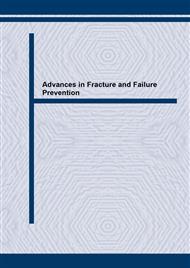p.1263
p.1269
p.1275
p.1281
p.1287
p.1295
p.1301
p.1307
p.1313
Super-Long Life Fatigue Behavior of Structural Aluminum Alloys
Abstract:
The objective of this study is to determine very long life fatigue and near threshold fatigue crack growth behaviors of 7075/T6 and 6061/T6 Al-alloys using piezoelectric accelerated fatigue at 19.5KHz. The experimental results show the fatigue failure can occur beyond 107, even 109 cycles, and endurance limits could not be obtained in the Al-alloys until 109 cycles. Fatigue voids are noticed on fatigue fracture in both alloys. By using scanning electron microscopy (SEM), the crack initiation and propagation behaviors have been examined. Fatigue crack growth rates of small cracks in the Al-alloys are found to be greater than those of large cracks at the same stress intensity factor range.
Info:
Periodical:
Pages:
1287-1294
Citation:
Online since:
April 2004
Authors:
Price:
Сopyright:
© 2004 Trans Tech Publications Ltd. All Rights Reserved
Share:
Citation:


